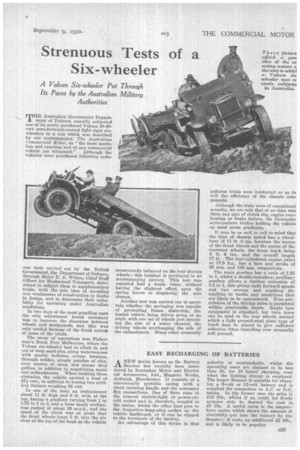Strenuous Tests of a Six wheeler
Page 47

If you've noticed an error in this article please click here to report it so we can fix it.
A Vulcan Six-wheeler Put Through Its Paces by the Australian Military Authorities
m'FrE Australian Government Depart tnent of Defence recently subjected one of its newly purchased Vulcan 30-40cwt, semi-forward-control light rigid sixwheelers to a test which was described by our contemporary, The Australian Commercial Motor, as 'the most merciless arid exacting test of any commercial vehicle yet witnessed." Although the vehicles were purchased following ardu
ous tests carried out by the British Government, the Department of Defence, through Major E. A. Wilton, Chief Staff Officer for Mechanical Transport, determined to subject them to supplementary trials, with the solo idea of revealing any weaknesses of construction or faults in design, and to determine their suitability for operating under Australian conditions.
In two days of the most gruelling tests the only adjustment found necessary was to increase the clearance between wheels and mudguards, and this was only needed because of the freak naturt of some of the trials.
The scene of operations was Fisherman's Bend, Port Melbourne, where the Vulcan six-wheeler had to climb in and out of deep sand-pits, along watercourses with muddy bottoms, _across swamps, through sodden, greasy patches of clay, over wastes of sand, and across deep gullies, in addition to negotiating acute wet embankments. When tackling these obstacles, the vehicle carried a load of 47i cwt., in addition to towing two artillery limbers weighing 38 cwt.
In one of the tests an embankment about 11 ft. high and 8 ft. wide at the top, having a gradient varying from 1 in 1.75 to 1 in 3, and a loose sandy surface, was rushed at about 20 m.p.h., and the speed of the climb was so great that the front wheels leapt 5 ft. into the air clear of the top of the bank as the vehicle momentarily balanced on the rear driving wheels ; this incident is portrayed in an accompanying picture. This test was repeated half a dozen times without having the slightest effect upon the spring leaves or displacing the axle clamps.
Another test was carried out to ascertain whether the springing was capable of preventing frame distortion, the loaded vehicle being driven along at an angle with one set of wheels just mounting the side of a water channel, the driving wheels overhanging the side of the embankment. Many other unusually arduous trials were conducted so as to teSt the efficiency of the chassis components.
Although the tests were of exceptional severity, we are told that at no time was there any sign of clutch slip, engine overheating or brake failure, the Dewandre servo-pattern brakes holding the vehicle on most acute gradients.
It may be as well to call to mind that the tYpe of chassis tested has a wheelbase of 11 ft. 6 ins, between the centre of the front wheels and the centre of the rearmost wheels, the front track being 5 ft. 4 ins., and the overall length 17 ft. The four-cylindered engine, rated at 17.9 h.p., has a bore and stroke of 85 ram. and 130 mm. respectively.
The main gearbox has a ratio of 7,25 to 1, whilst a double-reduction, auxiliary gearbox allows a further reduction of 2.5 to 1, this giving eight forward speeds and two reverse and enabling the machine to tackle any conditions that are likely to be encountered. Free articulation of the driving axles is permitted within practicable limits. Single tyre equipment is standard, but twin tyres can be used on the rear wheels, around which a light pressed-steel plate type of track may be placed to give sufficient adhesion when travelling over unusually soft ground.












































































































